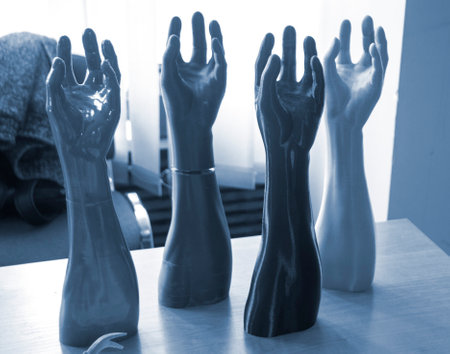Introduction to British Palmistry
Palmistry, often referred to as chiromancy, has held a unique place in British culture for centuries. Rooted in ancient traditions that travelled across continents, palmistry gained prominence in Britain during the Victorian era, when curiosity about the mystical and the occult was at its peak. While some may view it today as a parlour amusement, palmistry retains a devoted following and continues to intrigue many with its blend of folklore, symbolism, and personal insight. In modern-day Britain, palm reading is both a subject of serious study and a popular pastime at fairs, festivals, and private gatherings. This comprehensive guide will explore the major lines found on the palm according to British palmistry practices, offering historical context and discussing their contemporary significance within UK society.
2. The Life Line: Myths and Meanings
The life line is perhaps the most discussed and misunderstood of all the major palm lines in British palmistry. Often depicted as the sweeping curve that arcs from between the thumb and index finger down towards the wrist, this line has captivated both amateur enthusiasts and seasoned chirologists across the UK for generations.
Understanding the Life Line in British Tradition
In traditional British palmistry, the life line is not solely a measure of longevity, as is commonly believed. Instead, it reflects aspects of vitality, general well-being, and the potential for significant life changes. British practitioners tend to emphasise that this line indicates quality of life rather than its duration.
Typical Interpretations in the UK
| Life Line Characteristic | Common British Interpretation |
|---|---|
| Long and Deep | Strong constitution; energetic lifestyle; resilience to illness |
| Short but Clear | Efficient use of energy; may indicate focused life events rather than brevity of life |
| Faint or Broken | Periods of low vitality or significant life transitions; not an omen of misfortune |
| Double or Chained Line | Supportive relationships; adaptability during stressful times |
Common Misconceptions Addressed
A frequent myth encountered in the UK is that a short life line means a short life, which most professional palmists dismiss as a misconception. The British approach places greater importance on how robust or fragmented the line appears, interpreting breaks as markers of change rather than doom. Additionally, while some may believe scars or marks along the line predict accidents, experts highlight that these features are better seen as signals for potential turning points or challenges rather than predetermined fate.
Cultural Nuances in British Palmistry Practice
Unlike some continental European traditions that may take a more fatalistic view, British palmistry encourages a pragmatic interpretation. The focus lies on using insights from the life line to promote self-awareness and personal agency, rather than fear or superstition. This attitude is reflected in modern readings across London’s markets and rural fairs alike, where palm readers often blend tradition with encouragement for personal growth.

3. Decoding the Heart Line: Love and Relationships
In the realm of British palmistry, the heart line is traditionally regarded as a mirror to ones emotional life and social connections. This prominent crease, arching below the fingers and above the head line, has long been interpreted by British readers as a window into matters of affection, friendship, and emotional well-being.
The Traditional British View on the Heart Line
British palmists have historically approached the heart line with an air of pragmatic curiosity, seeking insights not only into romance but also into platonic bonds and community ties. Unlike some cultures where palmistry leans heavily on romantic destiny, in the UK, theres a notable emphasis on how the heart line reflects ones approach to loyalty, trustworthiness, and the balance between reserve and openness—a hallmark of classic British temperament.
Shape and Depth: What They Reveal
The shape and depth of the heart line are believed to carry significant meaning. A deep, clear heart line is said to indicate sincerity in relationships and straightforwardness in expressing feelings—qualities often admired in British social circles. Conversely, a fainter or fragmented heart line might suggest a more reserved or cautious approach to affection, perhaps echoing the famous stiff upper lip mindset.
Heart Line Endings: Friendships and Emotional Well-being
Where and how the heart line ends has its own interpretations in British palmistry. A heart line that curves upwards towards the index finger is typically seen as a sign of warmth and sociability, suggesting someone who values camaraderie and lasting friendships. If it ends under the middle finger, this might point to a more self-reliant nature or selective intimacy—again reflecting traditional British values around privacy and measured openness.
Overall, decoding the heart line from a British perspective goes beyond just love affairs; it encompasses the subtle art of forming genuine connections while maintaining personal boundaries. It offers a nuanced lens through which individuals can explore their patterns of affection, their capacity for empathy, and their overall emotional health within both romantic and platonic relationships.
4. The Head Line: Intellect and British Wit
In the grand tradition of British palmistry, the head line is often regarded as one of the most telling indicators of a persons intellectual capacity and unique sense of humour—qualities that are distinctly celebrated within British culture. Typically running horizontally across the palm, the head line sits just beneath the heart line and serves as a map to ones mental faculties, approach to problem-solving, and creative inclinations.
Understanding the Head Line
The head line reveals how an individual thinks, reasons, and communicates. A long, clear head line may suggest analytical prowess and a penchant for wit, while a shorter or more curved line could imply imaginative thinking or a playful sense of humour—a trait often admired in the UK. Palmists in Britain pay close attention not only to the length but also to the depth and curvature of this line, interpreting subtle variations with precision.
Common Head Line Features and Meanings
| Feature | Interpretation | British Cultural Association |
|---|---|---|
| Straight & Long | Logical, methodical thinker | Associated with traditional British pragmatism |
| Curved & Long | Creative, innovative mindset | Reflects appreciation for eccentricity and originality |
| Deeply Etched | Strong mental focus | Linked with academic rigour (think Oxbridge scholars) |
| Faint or Broken | Easily distracted or adaptable | Hints at dry humour or understated cleverness |
| Branches Upwards | Aspiring, optimistic thought patterns | Echoes the famous British “Keep Calm” resilience |
| Branches Downwards | Pessimistic or cautious thinking | Ties to self-deprecating British wit |
The Role of Humour and Wit in Interpretation
No exploration of the head line in British palmistry would be complete without acknowledging the integral role of humour. The renowned British wit—marked by irony, understatement, and sharp repartee—is frequently reflected in lines that display both strength and subtlety. When reading palms within a UK context, practitioners often consider whether breaks or quirks in the head line might suggest a penchant for clever banter or an ability to find levity in challenging situations. This nuanced approach distinguishes British palmistry from its continental counterparts, blending analytical observation with cultural context to provide insights that resonate deeply within local traditions.
5. Fate Line: Destiny and Opportunity in British Context
Within the tradition of British palmistry, the fate line—sometimes referred to as the line of destiny—holds a special place in interpreting ones journey through life, especially regarding career prospects, unexpected opportunities, and patterns of social mobility. The fate line typically runs vertically from the base of the palm towards the middle finger, though its length, clarity, and starting point can vary greatly among individuals.
Understanding the Fate Line in the UK
British palmists often view the fate line as a record of how external circumstances and personal choices shape an individuals professional path. In a society known for both its respect for tradition and its narratives of self-made success, the fate line is read not only as a symbol of predetermined destiny but also as a map of ones ability to respond to chance and seize new opportunities.
Career Trajectories and Occupational Luck
In the UK context, a strong and clear fate line is frequently associated with individuals who experience steady progress or notable achievement within their chosen careers. Palmists may interpret breaks or forks in the line as significant changes in employment or industry—echoing the modern British reality where career shifts and adaptability are increasingly valued. A fate line that starts at different points (for example, from the Mount of Luna or Life Line) can suggest influences from family background or self-initiative, resonating with Britains nuanced views on class and ambition.
Social Mobility and Unexpected Turns
The British approach to palmistry often highlights the fate lines role in representing social mobility. For those whose lines show interruptions or sudden changes, these markers might be read as moments where luck, societal factors, or personal decisions dramatically altered their trajectory—mirroring famous British stories of upward (or downward) mobility. In this way, the fate line becomes a tool for exploring how much of one’s life is shaped by hard work versus circumstance—a theme deeply embedded in local culture.
Ultimately, reading the fate line in Britain involves balancing an appreciation for personal agency with an understanding of external forces. Whether seen as a guide to navigating career uncertainty or as a reflection of one’s capacity to adapt to changing fortunes, this major palm line continues to intrigue both practitioners and clients seeking insight into their future paths.
6. Additional Lines and Their Local Interpretations
While the major palm lines—life, heart, and head—are the primary focus of British palmistry, several lesser-known lines also play a part in hand analysis. Among these, the sun line (sometimes called the Apollo line) and the mercury line (also known as the health or healer’s line) are noteworthy for their subtle yet intriguing meanings, especially when viewed through the lens of British tradition.
The Sun Line: Success with a British Twist
The sun line typically runs parallel to the fate line, towards the mount below the ring finger. In classic palmistry, it is associated with creativity, fame, and personal fulfilment. In Britain, however, interpretations tend to be more reserved. Rather than outright fame, a well-defined sun line may suggest quiet recognition within one’s community or a steady reputation built on consistent effort—a nod to British values such as modesty and perseverance. A faint or broken sun line might indicate untapped potential or a preference for working behind the scenes rather than seeking public acclaim.
The Mercury Line: Communication and Well-being
The mercury line starts near the base of the palm and rises towards the little finger. Traditionally linked to health and communication skills, British palmists often interpret this line in relation to social wit and dry humour—a staple of UK culture. A clear mercury line is thought to indicate good conversational abilities and an aptitude for diplomatic negotiation, while interruptions or waviness might hint at periods of stress or challenges in maintaining work-life balance. Interestingly, some practitioners note that people in professions such as teaching or public service frequently show strong mercury lines, reflecting their communicative roles.
Minor Lines with Local Nuances
Other minor lines, such as the girdle of Venus (associated with emotional sensitivity) or marriage lines (small horizontal marks on the edge of the palm), are also read with local flavour. British palmists may downplay dramatic interpretations in favour of more pragmatic advice—focusing on emotional resilience or practical partnership compatibility instead of foretelling fated love stories.
Regional Variations and Folklore
It is worth noting that regional differences exist even within Britain. In Scotland and Wales, for example, folklore sometimes weaves into palm readings, adding layers of meaning tied to local legends or historical figures. Rural readers might incorporate references to agricultural rhythms or seasonal cycles when interpreting minor lines—reflecting a deep connection between community identity and personal destiny.
Ultimately, while these additional lines may appear subtle compared to their major counterparts, they offer rich insights when interpreted with attention to British sensibilities: understated achievement, witty communication, and practical wisdom rooted in everyday life.
7. Contemporary Palmistry: Ethics and Modern Practices
Palmistry in the United Kingdom has experienced a significant transformation over recent decades, shifting from its roots in folklore and mysticism to become a more nuanced, reflective practice within contemporary society. This evolution has brought about fresh debates regarding the ethical responsibilities of palmists and the relevance of palm reading in modern British life.
The Changing Role of Palmistry
Today, palmistry is less likely to be seen as a means of fortune-telling and more often approached as a tool for self-reflection and personal insight. Many practitioners focus on helping clients understand their own tendencies, strengths, and potential challenges, rather than making deterministic predictions. This approach aligns with broader trends in British wellness culture, where holistic self-understanding is highly valued.
Ethical Considerations for Modern Practitioners
Ethics play a vital role in contemporary palmistry. Responsible palmists are careful to avoid making absolute statements about health, relationships, or financial matters, recognising the potential harm in creating false hopes or undue anxieties. They typically stress that palm readings are intended for entertainment or self-exploration, not as substitutes for professional advice from medical, legal, or financial experts.
Best Practices for Readers
Modern British palmists adhere to several best practices to maintain trust and integrity:
- Confidentiality: Respecting the privacy of clients by keeping all readings confidential.
- Consent: Ensuring that clients fully understand what a reading entails and agreeing to proceed without pressure.
- Non-judgemental Attitude: Providing interpretations without judgement or personal bias, fostering a supportive environment.
- Acknowledging Limitations: Being upfront about the scope and limits of palmistry, especially when addressing sensitive topics.
The Place of Palmistry in Modern British Culture
Palmistry continues to attract interest across Britain—at local fairs, festivals, and holistic events—often serving as a conversation starter or a means of self-discovery rather than prophecy. As society becomes increasingly diverse and sceptical of superstition, many practitioners position themselves as guides rather than seers, offering insights that encourage reflection rather than fate-based certainties.
This contemporary outlook ensures that palmistry remains both relevant and respectful within modern British culture. By adhering to ethical standards and prioritising the well-being of those who seek their guidance, today’s palmists contribute positively to the evolving landscape of spiritual and personal development in the UK.


